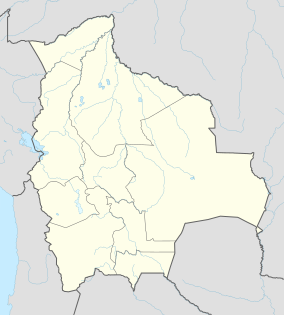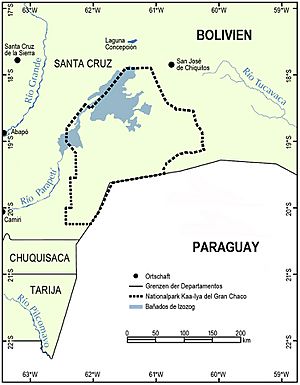Kaa-Iya del Gran Chaco National Park and Integrated Management Natural Area facts for kids
Quick facts for kids Kaa-Iya del Gran Chaco National Park and Integrated Management Natural Area |
|
|---|---|
| Location | Bolivia Santa Cruz Department |
| Area | 34,411 km² |
| Established | September 21, 1995 |
| Governing body | Servicio Nacional de Áreas Protegidas (SERNAP) |
The Kaa-Iya del Gran Chaco National Park and Integrated Management Natural Area is a huge national park in Bolivia. It is one of the biggest parks in all of South America. This special protected area is found in the Gran Chaco region. It is even larger than the country of Belgium!
The park is located in the southern part of the Santa Cruz Department. It shares a border with Paraguay.
What Does Kaa-Iya Mean?
The name Kaa-Iya comes from Guarani mythology. It means "mountain owners". This name also refers to a place rich in natural resources. It shows the strong connection between people and nature in this area.
Park Geography and Climate
Kaa-Iya is a massive park. It covers about 3,441,115 hectares, which is over 34,000 square kilometers. The land here ranges from 100 to 839 meters above sea level. The park gets between 400 and 1,400 millimeters of rain each year. The main river flowing through the park is the Parapetí River.
Unique Features of the Park
This park is famous for having the largest tropical wooded area in the world. It is also home to an amazing variety of animals. Many large felidae (big cats) live here. More than 100 different kinds of mammals call this park home.
Kaa-Iya del Gran Chaco is connected to other important areas. These include Otuquis National Park and the new Ñembi Guasu conservation area. Together, these areas protect about 60,000 square kilometers of the Gran Chaco forest.
Plant Life in Kaa-Iya
Scientists have found 880 types of vascular plants in the park. These are plants with special tissues to carry water and nutrients. They have also recorded 28 types of spore plants, which are plants without flowers. It is thought that there are about 1500 types of higher plants in total.
Some important trees you might see include the red quebracho and black soto. Other notable plants are the cuchi and purple guayacán. You can also find the floss silk tree and mistol. There are also different types of palm trees, like the wax palm.
Amazing Animals of Kaa-Iya
The park is full of animals typical of the Chaco plains. There are 350 recorded species here. This includes 89 types of snakes and 301 types of birds. You can also find 65 types of small mammals and 59 types of large mammals.
One special animal is the Chacoan peccary, also called tagua. This pig-like animal is common in the Chaco. You can also see armadillos, the Chacoan mara, and Conover's tuco-tuco.
Big Cats and Other Predators
Kaa-Iya is well-known for its large cat population. You can find jaguars, pumas, and ocelots here. The maned wolf also lives in the park.
The park is considered one of the best places in the world to see jaguars. A study using camera traps estimated that over 1000 jaguars live in the park. This makes Kaa-Iya very important for the survival of these big cats. Other animals like tapirs are also often seen.
Other Unique Wildlife
In the sandy areas of the park, guanacos have been seen. These animals are related to llamas. Other animals found here include the white-lipped peccary and the giant armadillo. You might also spot the silvery marmoset or the black howler monkey. Birds like the bare-faced curassow, harpy eagle, and black-and-white hawk-eagle also live in the park.
People of the Park Area
The people living near the park are mainly the Guaraní and Chiquitano communities. There are also farmers in the area. Most people live around the edges of the park.
Many Guaraní communities are found in the west, including Guarirenda and Yapiroa. The largest Chiquitana community is San Pablo, located in the north. Some groups of Ayoreode people, including uncontacted nomadic groups, also live here.
The ruins of San Ignacio de Zamucos are in the southeastern part of the park. This was a Jesuit mission from 1724 to 1745.
How the Park is Managed
The Kaa-Iya National Park is managed through a special agreement. This agreement was signed in 1995 with the Upper and Lower Izozog Authority. This is an organization of the indigenous Izoceño-Guaraní people. This means the park is managed together by the government and local indigenous groups.
The management committee includes people from different towns and indigenous groups. This shared approach helps protect the park and its resources.
Why Kaa-Iya is Important
This park is the only protected area that covers a large part of the South American Chaco. It protects most of the unique ecosystems found in this region.
Even though its landscape might seem simple, the park has amazing wildlife. This makes it a great place for eco-tourism and adventure tourism. The presence of indigenous groups like the Izoceño, Chiquitano, and Ayorea people also makes the area special. They create beautiful craftwork.
The park is also a vital natural home for many different plants and animals. It also protects the unique cultures of the indigenous Guaraní people. Its natural and cultural value means it has great potential for tourism.
Challenges Facing the Park
The park faces some serious threats. One major threat comes from activities related to oil and gas. This includes searching for oil and gas and building pipelines. Another threat is the expansion of farms and cattle ranches. Illegal hunting and changing the flow of the Parapetí River for farming also cause problems.
Getting to Kaa-Iya
Access to the park can be difficult, especially during the rainy season. Many roads become unusable. The main road that borders the park is the Santa Cruz-Bajo Izoso-Camiri road. In many areas, you can only enter on cattle paths. It is best to visit the park through a licensed tour operator from Santa Cruz, Bolivia.
Images for kids
See also
 In Spanish: Parque nacional y área natural de manejo integrado Kaa Iya del Gran Chaco para niños
In Spanish: Parque nacional y área natural de manejo integrado Kaa Iya del Gran Chaco para niños



